MCHS grads met for lunch on July 22, 2021, at Long Point Provincial Park on Lake Erie
Update: At this post I talk about ticks and Lyme Disease. I recently came across an article about this topic, well worth reading; a September/October 2020 Walrus article is entitled: “Invasion of the Ticks: Inside the quest to track one of humanity’s tiniest deadly predators.”
[End of update]
*
Until we met on Thursday, July 22, 2021 at Long Point Provincial Park on the north shore of Lake Erie, we had endured a ten-month break from our Malcolm Campbell High School (MCHS) picnics in Toronto and elsewhere.
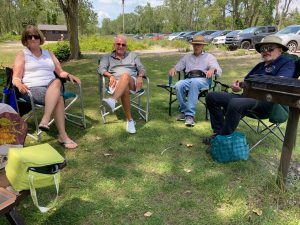
Left to right: Gina Cayer, Peter Reich, Jaan Pill, Scott Munro at Long Point Provincial Park, July 22, 2021. Jaan Pill photo
MCHS is a high school located in Montreal that I graduated from in 1963. I much enjoy meeting fellow graduates and teachers – and also people who attended even without graduating – and their friends and families.
In previous years some MCHS grads have often met indoors at Mandarin restaurants in Toronto and Kitchener.
Seventeen months ago, however, we decided in light of COVID-19 to switch to outdoor lunches.
We’ve previously met for picnics in Woodstock on Aug. 20, 2020, Cliff Lumsdon Park on Lake Ontario in Toronto on Sept. 24, 2020, and Stratford on Sept. 30, 2020.
Since the September 2020 Stratford meeting we had taken a 10-month break on account of the ongoing pandemic. On July 22, 2021 we met once again, this time at Long Point Provincial Park on Lake Erie.
We’re planning future meetings in London, Toronto, and Kitchener. MCHS grads and family members and friends are welcome to join us. Send me an email at jpill@preservedstories.com if you wish to be on our email list. Doesn’t matter what year you graduated.
In-person meetings
I found it most interesting to drive to Long Point from Stratford on the morning of July 22 using Google Maps on my iPhone to find the way. Given the previous months of social distancing, it was great to meet with friends from MCHS once again.
I much enjoyed meeting with Gina Cayer, Peter Reich, and Scott Munro on July 22 at this park on Lake Erie, which Gina had suggested as a great venue. We had messages from four other persons who were unable to attend given other commitments on this day. It’s good to know there’s plenty of interest in our get togethers.
The park on a sand spit extending into Lake Erie, was one that I had not know about until now. I’ve now been reading, online and in history books about Long Point, whose Indigenous history goes back to the last ice age.
I’ve found it remarkable that the colonial settler history of the area is strongly reminiscent of the history of Long Branch on the Lake Ontario shoreline in Toronto where I used to live. I’m thinking for example of the quick deforestation that occurred in both areas with resultant flooding.
As well, there are parallels in land use planning strategies (related to military defence in response to potential invasion by American forces) connected with settlement after the American Revolutionary War and in the context of the War of 1812. As I’ve mentioned elsewhere, Indigenous warriors played a key role on behalf of the British side during the latter war. After the conflict ended, however, the decisive Indigenous contribution to the military outcome was ignored in the ensuing peace treaty.
For their own respective reasons (related to nationalist public relations imperatives and historiographies), among the European settler societies in North America both the Canadian and American side has each claimed that it won the War of 1812 but there is some consensus among historians, from what I can gather, that the losing side in the War of 1812 was the First Nations side.
World Biosphere Reserve
Established in 1921, the park is part of a designated World Biosphere Reserve as noted at a link entitled: Long Point Provincial Park.
A Working Paper 6 (1994) from the Heritage Resources Centre at the University of Waterloo is entitled: Human History of the Long Point Area.
Given my interest in Indigenous history, I checked an online CBC interactive map to find out where the closest residential school in relation to Long Point had been located. The closest school was in Brantford: “At 80 kilometres, the residential school nearest to this address was Mohawk Institute. This school was in operation from 1831 until 1970.”
An Ontario educator who was a key player in the founding of Canada’s residential schools has a family connection to Long Point as the above-mentioned Heritage Resources Centre working paper notes. A university is named after him; a statue depicting him has recently been torn down and will not be replaced.
There are no park fees to pay if you visit from Monday to Thursday but a daily vehicle permit, which can be ordered online in advance, is required. Gina Cayer has commented that the parking lots and beach are absolutely packed on weekends.
I can add that a notice at the Norfolk County Tourism website reads: “Norfolk County’s Tourism office recommends that tourists should park vehicles at Long Point Provincial Park for the best beach experience. The Ontario Ministry of Natural Resources is the steward of the beachfront along the entire stretch of Long Point from the provincial park to the causeway. However, beach-goers in the area outside of the Provincial Park are asked to respect the property owners who live near the beach.” That is to say, sometimes the roadway leading to the park entrance is also packed with cars.
Big Creek National Wildlife Area
On the way back to Stratford I stopped at the Big Creek National Wildlife Area. It was great to hear the birds and toads. I climbed a watchtower where I could look around in all directions. I regularly walk in parklands in Stratford where I live and thought that Big Creek would also be a great place to go for a walk.
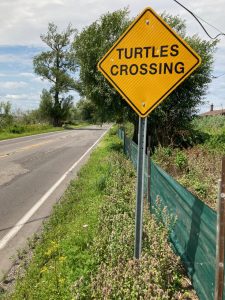
On the roadway heading away from Long Point Provincial Park near the entrance to Big Creek National Wildlife Area. Jaan Pill photo
I also stopped, on my drive back to Stratford, to take a photo of a Turtles Crossing sign. Gina has mentioned she saw me taking pictures as she was driving from the park.
What we talked about
We had many interesting discussions about the local history of the park, including activities of the Long Point Company, which in 1866 (as the Heritage Resources Centre working paper notes, p. 33) purchased about 6044 hectares of land on the Long Point peninsula – land that was ideal as private property for hunting and related pursuits. The Charter of the Company, the working paper explains, “controlled issuance of licenses to hunt, trap and fish on its property.”
We also spoke about the popularity of French immersion among area parents (so local kids can get government jobs when they grow up) and the rise in house prices in the hamlet of Long Point which you pass through on your way to the park. We spoke as well of occasional flooding in the area and steps homeowners are taking in the face of increasingly frequent, extreme weather events.
Scott and Gina spoke of the light rail transit (LRT) that now runs in Kitchener and may be extended to Cambridge. Gina commented that in Montreal the extension of an existing light rail line is also in the works, and a new Champlain bridge has been built with an LRT running on it. Not having visited Montreal for some years I was interested in these transit updates.
We noted that we have to take care when travelling in the US (this applies I guess anywhere) as otherwise your iPhone and credit cards may get stolen. We also talked about ticks and Lyme disease. I wear long pants and a long-sleeved shirt pretty well all the time especially when outdoors off the beaten track.
Both Gina and Peter have a connection to Ahuntsic. Peter learned about the July 22 picnic from Lynn Legge as I understand.
There’s plenty more to report, about what we talked about including additional comments of interest from Peter and Scott as well as from Gina but I’ll sign off for now as it’s time to go for a walk.

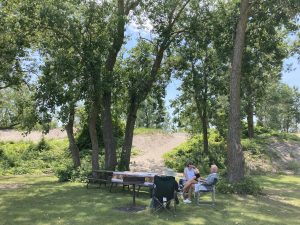
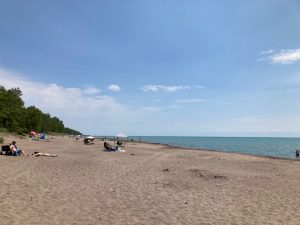
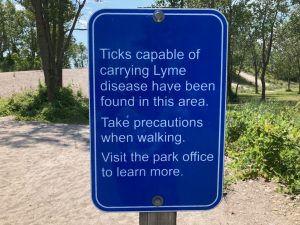
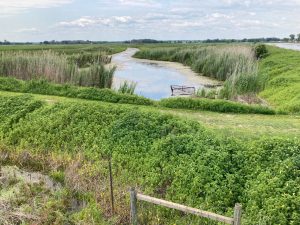
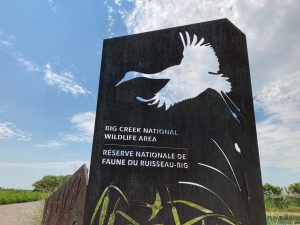
With regard to deforestation I’m reminded of a book by Robert G. Wallace entitled: Dead Epidemiologists: On the Origins of COVID-19 (2020). A blurb reads:
‘Dead Epidemiologists’ is a collection of commentaries, articles, and interviews revealing the hidden-in-plain-sight truth behind the pandemic: Global capital drove the deforestation and development that exposed us to new pathogens. Rob Wallace and his colleagues – ecologists, geographers, activists, and, yes, epidemiologists – unpack the material and conceptual origins of COVID-19.
An earlier book by Robert G. Wallace is entitled: Big Farms Make Big Flu: Dispatches on Infectious Disease, Agribusiness, and the Nature of Science (2016).
A blurb reads:
Thanks to breakthroughs in production and food science, agribusiness has been able to devise new ways to grow more food and get it more places more quickly. There is no shortage of news items on hundreds of thousands of hybrid poultry – each animal genetically identical to the next – packed together in megabarns, grown out in a matter of months, then slaughtered, processed and shipped to the other side of the globe. Less well known are the deadly pathogens mutating in, and emerging out of, these specialized agro-environments. In fact, many of the most dangerous new diseases in humans can be traced back to such food systems, among them Campylobacter, Nipah virus, Q fever, hepatitis E, and a variety of novel influenza variants.
Agribusiness has known for decades that packing thousands of birds or livestock together results in a monoculture that selects for such disease. But market economics doesn’t punish the companies for growing Big Flu–it punishes animals, the environment, consumers, and contract farmers. Alongside growing profits, diseases are permitted to emerge, evolve, and spread with little check. “That is,” writes evolutionary biologist Rob Wallace, “it pays to produce a pathogen that could kill a billion people.”
In Big Farms Make Big Flu, a collection of dispatches by turns harrowing and thought-provoking, Wallace tracks the ways influenza and other pathogens emerge from an agriculture controlled by multinational corporations. Wallace details, with a precise and radical wit, the latest in the science of agricultural epidemiology, while at the same time juxtaposing ghastly phenomena such as attempts at producing featherless chickens, microbial time travel, and neoliberal Ebola. Wallace also offers sensible alternatives to lethal agribusiness. Some, such as farming cooperatives, integrated pathogen management, and mixed crop-livestock systems, are already in practice off the agribusiness grid.
While many books cover facets of food or outbreaks, Wallace’s collection appears the first to explore infectious disease, agriculture, economics and the nature of science together. Big Farms Make Big Flu integrates the political economies of disease and science to derive a new understanding of the evolution of infections. Highly capitalized agriculture may be farming pathogens as much as chickens or corn.
With regard to the history of land use in Southwestern Ontario I’m reminded of a 2017 dissertation by Hayley Goodchild which I’ve mentioned at a previous post, an excerpt from which reads:
Hayley Goodchild dissertation
I’ve also mentioned that I am very much impressed with a 2017 PhD dissertation by Hayley Goodchild regarding the history of the Ontario dairy industry from the 1860s to the 1930s. I’ve mentioned the thesis in an article about local history in Stratford, Ontario:
The R.M. Ballantyne Ltd. textile plant was built by a thread company, which ran into financial difficulties, and was first occupied by a motor company which built a bus, that startled the horses
The thesis mentions a study or studies by James C. Scott. A key conclusion of the Hayley Goodchild dissertation is that the attempt to ‘reform’ the Ontario dairy industry by building cheese factories starting in the 1860s to supply the British demand for cheese ran into a particular problem. That problem was that the reformers were keen to manage nature but nature wasn’t amenable.
As James C. Scott has underlined, nature does not respond well to being managed. Among other things, as both Scott and Goodchild underline, because humans don’t have sufficient understanding or comprehension of nature, attempts to manage nature – including human nature – on a large scale are not going to work as expected. Unintended consequences will arise instead.
Click here for previous posts about James C. Scott >